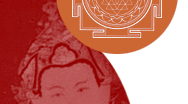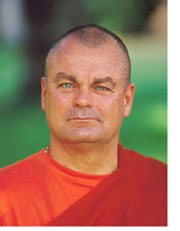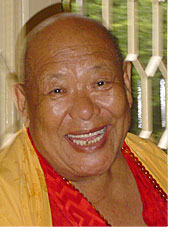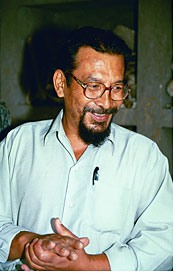


~ Swami Chetanananda | ~ Lama Tsering
Wangdu Rinpoche | ~ Sudarshan Suwal
~ Ravindra Jyapoo
Swami Chetanananda
 Swami Chetanananda is
an American meditation master and the abbot and spiritual director of
Nityananda Institute. He studied with Swami
Rudranananda (Rudi), who was a student of Bhagavan
Nityananda of Ganeshpuri, one of the greatest Indian saints of the
20th century. Upon Rudi’s death, Swami Chetanananda took over the
direction of the ashrams established by Rudi.
Swami Chetanananda is
an American meditation master and the abbot and spiritual director of
Nityananda Institute. He studied with Swami
Rudranananda (Rudi), who was a student of Bhagavan
Nityananda of Ganeshpuri, one of the greatest Indian saints of the
20th century. Upon Rudi’s death, Swami Chetanananda took over the
direction of the ashrams established by Rudi.
In subsequent years, Swami Chetanananda studied with Swami Muktanananda,
from whom he took initiation in 1978 and became a swami in the Saraswati
order. He also studied with Dr. Rollin Becker, a gifted osteopath in the
tradition of Drs. Sutherland and Still. He has accomplished the Ati Yoga
training of the Nyingma school of Tibetan Buddhism, which he studied with
Lama Tsering Wangdu Rinpoche. Recently, he has continued to develop his
spiritual work by studying and practicing with Shaiva tantric healers
in the Kathmandu Valley.
Swami Chetanananda has traveled extensively, exploring the religious practices
of many cultures, especially the ancient Kashmir Shaivite practice of
Trika Yoga,
the philosophical framework in which the practice of kundalini yoga is
a vehicle for realization. He is recognized as an authority on Trika Yoga
meditation and the philosophy and ancient tantric practices of Kashmir
Shaivism.
Swamiji has expertise in Indian, Tibetan and Indonesian art, as well as
the history and archaeology of the Far East. He has studied, in depth,
hatha yoga, osteopathy, homeopathy and acupuncture. He is the author of
several books on spirituality, including Dynamic Stillness, The Breath
of God, Open Heart, Open Mind, Choose to Be Happy,
Will I Be the Hero of My Own Life? and There Is No Other.
Swami Chetanananda also oversees a program for translation of Shaiva and
Tibetan Buddhist texts. He was the co-chairman of Nityananda Institute’s
joint research project with the Center for Nepal and Asian studies of
Tribhuvan University regarding the Karmacharyas
of Bhaktapur.
Swami Chetanananda has been traveling to Nepal for many years and now
spends several months each year in residence in Kathmandu.
More information about Swami Chetanananda is available at his home
page, www.chetanananda.org. A collection of published articles by
Swami Chetanananda can be found at www.chetanananda.com.
Lama Tsering Wangdu Rinpoche
 Lama Tsering Wangdu Rinpoche
was born in the village of Langkor in West Dingri, Tibet, near the Mt.
Everest region, in 1936. He began studying with his guru, Napdra Rinpoche,
at age 8.
Lama Tsering Wangdu Rinpoche
was born in the village of Langkor in West Dingri, Tibet, near the Mt.
Everest region, in 1936. He began studying with his guru, Napdra Rinpoche,
at age 8.
When Rinpoche was in his early twenties, Napdra Rinpche sent him on retreat
to 100 cremation grounds, where he had many profound experiences. Upon
conclusion of the retreat, his teacher acknowledged his accomplishment
in the practice and sent him on pilgrimage to Nepal, where he arrived
in 1958. Rinpoche eventually made his way to the Kathmandu Valley, where
he settled in the Tibetan refugee camp in Jawalakehl. He lived for many
years among the refugees, and became one of the few pujaris (ritual practitioners)
accessible to both the Tibetan refugee population as well as the local
Nepalese community. He is well-known in Kathmandu for his powers as a
healer.
In addition to studying with Napdra Rinpoche, Rinpoche has received teachings
and transmissions from many extraordinary lamas, including His Holiness
the XIVth Dalai Lama, His Holiness Dudjom Rinpoche, His Eminence Surkhang
Rinpoche, His Eminence Urgyen Tulku, and His Eminence Chatral Rinpoche.
Swami Chetanananda met Rinpoche during a trip to Nepal in 1997, and they
both describe their first encounter as the meeting of two currents. They
immediately recognized the authenticity of the other’s spiritual
work and the complementary nature of their practices. Since then, they
have spent extensive time together, sharing knowledge and experiences.
In August 1999, Rinpoche made his first trip to the United States, travelling
to Bloomington, Indiana to attend the Kalachakra initiation and spending
several months in Portland, Oregon. He has spent several months each year
in Portland and has visited Los Angeles and New York City. During his
visits, he has practiced with Nityananda Institute students, given teachings
and initiations, and worked on translations of texts from Padampa Sangye,
Machig Labdron and from the Longchen Nyingthig tradition.
Rinpoche is a master of the practice of Chöd. Chöd is an ancient
tantric practice that teaches about the essence of sacrifice. It is traditionally
performed in cremation grounds and other frightening places where emotional
energy is intensified. Using a drum, bell and thighbone trumpet, the Chöd
practitioner summons all harmful spirits and offers them a visualized
feast consisting of the practitioner’s own body. Through Chöd,
a practitioner learns to cut through attachment to appearances and come
to understand the underlying unity of all things. In the hands of a practitioner
such as Lama Wangdu, Chöd is also a powerful ritual for physical
and mental healing and pacifying environmental disturbances. Rinpoche
is the last person of his lineage to have completed the traditional training.
In March 2003, Rinpoche attended teachings by His Holiness the XIV Dalai
Lama in Dharamsala, India. During that visit, His Holiness told him that
the Zhi-je teachings of Padampa Sangye, including practices for the pacification
of suffering, were especially precious and relevant to contemporary conditions.
His Holiness asked Rinpoche to establish a monastery in Kathmandu to continue
these teachings in Nepal.
Sudarshan
Suwal
 Sudarshan
Suwal comes from a family of artists. He began studying painting at age
12, receiving most of his training from his grandfather, a master of Newari
Buddhist style of classical painting. His grandfather was a tantric practitioner,
so Sudarshan’s education included instruction in meditation, mantra
and visualization, as well as drawing, making pigments, and painting.
He began by painting simple figures, like the Buddha, Ganesh and Saraswati,
and eventually progressed to more complex subjects.
Sudarshan
Suwal comes from a family of artists. He began studying painting at age
12, receiving most of his training from his grandfather, a master of Newari
Buddhist style of classical painting. His grandfather was a tantric practitioner,
so Sudarshan’s education included instruction in meditation, mantra
and visualization, as well as drawing, making pigments, and painting.
He began by painting simple figures, like the Buddha, Ganesh and Saraswati,
and eventually progressed to more complex subjects.
.
Classical paintings in the Newari tradition are called paubha,
although they are more commonly known by their Tibetan name, thangkas.
For centuries, thangkas were painted using natural pigments made from
vegetable and mineral sources. With the recent popularity of chemical
pigments, the classical tradition is in danger, as there are only a handful
of artists painting today who use the classical techniques.
For many generations, Sudarshan’s family has carefully guarded the
techniques for making mineral pigments: which minerals to use, how to
select them, and how to prepare them for painting. That knowledge was
considered sacred, to be handed down only within the family line. Only
recently has Sudarshan begun to share the technique with outsiders. He
has started teaching in the hope that sharing the knowledge will help
to preserve the tradition. He is giving instruction only to students who
are spiritual practitioners, as he believes that devotion to the dharma
is essential for a thangka painter.
Sudarshan is recognized as one of the finest traditional painters in Nepal.
He has won prizes in national competitions, and his work has been exhibited
at solo shows in Nepal and in Denmark. In 2001, he was invited to teach
at Sechen Monastery in Bhutan. He has worked on wall paintings in the
Vasundhara Temple at Swayambhu. He also worked on decorative wall paintings
for the set of Little Buddha.
Sudarshan was born in 1963 and grew up in the heart of Kathmandu, not
far from Durbar Square. He learned a lot of his English from the hippies
who visited Freak Street in the 1960’s and 70’s. He now lives and works
in Patan.
Sudarshan’s paintings demonstrate the beauty of natural pigments.
The colors in his work are vibrant, with a freshness and intensity that
chemical pigments cannot reproduce. Sudarshan has painted over 550 thangkas
so far, including a 12 foot by 8 foot mandala of the sun god, Surya, that
took up the entire floor space in his small studio. He has done work for
the commercial market as well as commissions for private collectors, including
Nityananda Institute Nepal. His spectacular painting of Siddhi Lakshmi
hangs in the meditation room in Nityananda Institute’s Portland
ashram, and a number of his other works are displayed at the Nityananda
Institute Nepal center.
More information about Sudarshan Suwal is available at the Natural
Collection Traders site.
Ravindra
Jyapoo
 Ravindra
Jyapoo is a sculptor and a master bronze caster and, in Nepal, a rare
person. Ravindra comes from a family of farmers and is in the first generation
of his family to become an artist. Ravindra pursued a difficult path,
because his parents were opposed to his chosen career and because he was
not accepted into the Sakya (or artist) caste to study.
Ravindra
Jyapoo is a sculptor and a master bronze caster and, in Nepal, a rare
person. Ravindra comes from a family of farmers and is in the first generation
of his family to become an artist. Ravindra pursued a difficult path,
because his parents were opposed to his chosen career and because he was
not accepted into the Sakya (or artist) caste to study.
Left to learn on his own, Ravindra worked diligently for years and completed
basic sculpture studies at a lower level art school in Kathmandu—the
only training available at the time. After completing his schooling, he
worked first with a private firm in Patan as a molder of traditional pieces
for commercial sale, and then for the National Museum, learning about
reproductions and conservation of existing works.
None of Ravindra’s training was in portraiture, however. For that,
he was entirely on his own. One of his early efforts was a sculpture he
did of a friend when he was 18; the result was a remarkable likeness.
Ravindra started his own workshop in his home in 1984. For many years,
the tiny three room building housed his family of seven children and his
studio. Over the years, the building has been expanded in all directions
to accommodate the growth in demand for Ravindra’s work.
Ravindra’s first commissioned work was a bust of the late King Mahendra.
He has worked on sculptures of prominent citizens of Nepal and on more
traditional religious subjects. One of his favorite pieces is a bust of
Sir Edmund Hillary that was installed in a school in Nepal’s Solukhumbu
region. In the photos of the piece, Hillary’s energy is so alive
it crackles on the page.
Ravindra began to receive recognition for his work. He has won awards
in national exhibitions. He was among the artists in the Valley who were
asked to participate in the set design for the movie Little Buddha,
which was filmed in Kathmandu. Today he is a well-respected artist and
considered the best in portraiture in Nepal. Among his current projects
is a statue of Swami Rudrananda (Rudi) for Nityananda Institute's Portland
center.
Ravindra is eager to share his knowledge with other aspiring sculptors.
His house at the base of the Swayambunath stupa is, on most days, full
of students, both foreign and local, who come for the joy of working with
him. Ravindra has been teaching art at the Lalitkala campus of Tribhuvan
University, where he is a senior professor. He is a member of the Royal
Nepal Academy, an organization devoted to the preservation and promotion
of Nepali art and culture.

![]()
![]()